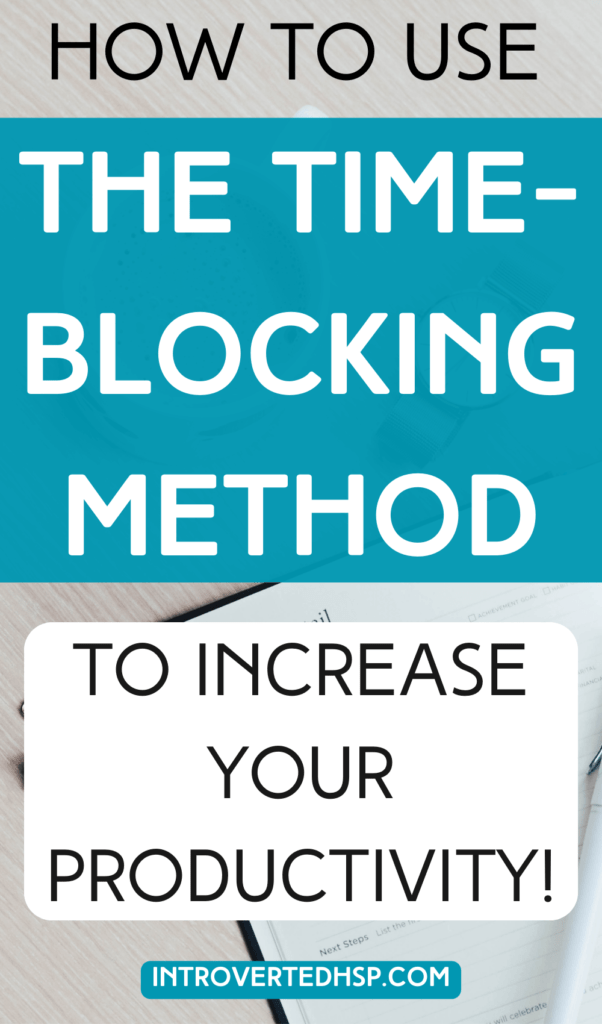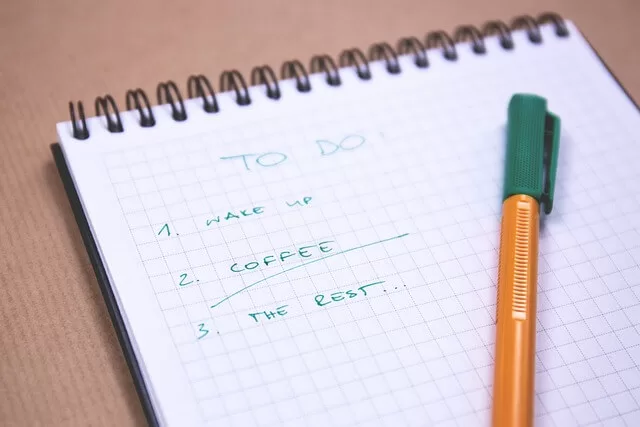We all want to be as productive as we can be without sacrificing our mental health while doing so. Learning and implementing new productivity techniques, such as the time-blocking method, can help you improve your productivity levels without putting in more hours at work.
Being productive means having a good output on any activity that you choose to do where there is a goal to be reached, whether it is work-related or more family life-related. You want to reach your personal or work-related goals and only use up the energy you need for a certain task. This way, you will have some more energy left to do things you enjoy!
Of course, there are also periods in your day when you don’t have to be productive, we are not robots! But if you use this time-management technique, you are likely to have more free time to take a step back and relax.
Let’s learn more about time blocking, what it is, how you can use it in your life, and why you need it so badly.

This post may contain affiliate links, which means if you make a purchase through these links, I may receive a small commission at no extra cost to you. As an Amazon Associate I earn from qualifying purchases. Please read my disclosure for more info.
What is time blocking
Time blocking is a time-management technique that is created to help you use your time more productively.
You will group tasks that are related to each other and assign them a certain amount of time to work on them in your calendar. This way, you can fill your whole agenda with blocks of time that have a purpose to fulfill. You will always know what needs to be done next and have a plan to follow through your day.
It’s meant to help you control how you spend your time better and don’t waste your time thinking about what to do next. It will also improve your focus because you can give your attention to one type of task at a time.
The time-blocking method is often confused with other time-management strategies like time boxing, day batching, or task batching. They look very similar but have their differences. Time boxing is giving each little task its time frame instead of combining multiple tasks per block of time. Day batching is setting one type of work per day and task batching means working on a task until it is finished and only then going on to the next one.
How do you use time blocking
How do you start time blocking step by step? It’s not difficult at all, you just need to follow the next steps one by one, and off you go!
To-do List

Before you can start filling your agenda with blocks of time, you should know which tasks need to be done. This is a very important first step!
You can create a to-do list every single day for the next day, or even look ahead to your entire week. When you do this is up to you, as long as you know which tasks you need to do before you have to do them so that you can make a plan. Write every task down that needs to be done.
A to-do list can be very long, so you should set priorities to not overwhelm yourself every day. What are the things you need to do on a certain day, are there any deadlines that you should take into account? Organize your to-do list by setting priorities and deadlines for certain tasks.
Task Groups
When you know everything that you need to do, start looking for similar tasks. When you have very similar tasks, you can combine them in a block of time because they require the same approach and focus level. Combining similar tasks will help improve your productivity. You can assign a category to every task group with its own to-do list.
Let me give you an example. Doctors often set aside a block of time in their agenda to do only consultations and another block of time to do surgery. It would be less productive for them to do a surgery, then a consultation, and then another surgery because this breaks their flow and they need different skills for these tasks and different locations.
This is the same for people working in offices. When you are constantly interrupted by incoming emails or phone calls, you will lose focus on the more difficult tasks that you need to do. You will need to find your focus back and because this takes a while, it’s the opposite of being productive. If you assign a period to check your emails and then a block of time for deep work, you will see that you can do your deep work more efficiently!
Start Time Blocking
When you have listed all the tasks that you need to do and grouped them as much as possible, then it is time to create a schedule with time blocks. Let’s start time blocking!
Every block of time has a category and to-do list. This can be admin, emails, marketing, creation, meetings, etc.
It can be difficult at first to know how much time you need to do certain tasks. Therefore, it is recommended when you first start time blocking to overestimate how much time you need so that you will have enough time and don’t get stressed out.
You can end your work week by creating a schedule for the next week or do this first thing Monday morning. You could also end every day by creating a schedule for the next day if you want to do it daily.
It’s important to start every day by looking at your schedule so that you know what to do next and where your focus should be.
Buffer Time

It’s always a good idea to add some buffer time blocks into your day. These can be used as breaks or when you are running late finishing a certain task. When you first start time blocking, it might be a good idea to add breaks as well as buffer blocks, because when you are always running late, you will never get to take a break!
Every person needs to have breaks during their workday, so keep that in mind while creating your daily schedule. Some people like to have empty spaces in their agenda to do whatever they want while others like to see a block with ‘break time’ or something like this. Do whatever you like best.
Example
Let me give you an example of a possible workday using time blocking.
- 7-8: morning routine
- 8-9: commute
- 9-10: emails
- 10-11.30: deep work
- 11.30-11.45: break
- 11.45-13: focus work
- 13-14: lunch
- 14-15: meetings
- 15-16.30: flexible time
- 16.30-16.45: break
- 16.45-17.30: emails
- 17.30-18: prepare for tomorrow
- 18-19: commute
- 19-22: evening routine
- 22-23: me-time
- 23-7: sleeping
If you work at a job where your schedule is prone to last-minute changes or deadlines that just pop up out of nowhere, it might be a good idea to add a block with flexible time. With this flexible time block, you can do the work that you planned to do earlier when you got disturbed by another important task.
Self-care and personal time
You can’t be productive all the time. Always being productive is a recipe that leads to burnout so try to achieve a good work-life balance. Take good care of yourself and use time blocking to assign certain periods to focus solely on yourself. Schedule me-time into your busy schedule and don’t skip it for your own good.
Many career-driven people and high achievers don’t feel good about just relaxing. They always want to be productive and do something useful. But this isn’t good for them in the long term. Sometimes you need to take your focus off work and have a moment for self-care. You deserve this and you can be so much more productive after having some downtime!
Adapt
I love paper planners, and you can totally use time blocking on paper planners, but this is much less flexible than when you use the digital calendar on your phone or computer. There are also many great time-blocking apps, you can find a few in this blog post.
When you first start time blocking, there is a lot to get used to and probably a lot of things that need some adaptation. You need to figure out at what moment in the day you want to do certain tasks when you have the most energy and how much time you need for every task.
Don’t panic when you are running out of time, just reschedule every block in your planner and next time, try to foresee a little more time for that type of task. It’s all about being flexible.
Time blocking is not meant to create a very rigid schedule. The main goal is to help you focus on what needs to be done so that you get everything done on time. Because you have a schedule, you will always do more than when you are just winging it, even if it’s not always going according to your plan.
You might notice that when you first start time blocking, you will struggle with this single-tasking as your mind looks for distractions. But when you keep focusing on one task at a time, your brain’s capacity to focus will improve and you will find yourself with more focus than ever before! You will get so much more done this way!
Why do you need time blocking

If you haven’t found a good time management strategy that works for you just yet, maybe it’s time to give time blocking a try.
Time blocking is great for:
- Procrastinators: A lot of people tend to procrastinate on difficult or boring tasks. With time blocking, you can tackle these hard tasks more easily because you have chosen a set period to do them. Follow your plan.
- Distracted People: When you are easily distracted, time blocking might be great for you. It will let you focus on one type of task at a time, you can develop more focus by single-tasking and get more done because of this focus. It’s a great technique for doing deep work!
- Perfectionists: After some time, you must stop doing a task even if it’s not completely done according to your standards. This way, you might learn to be okay with good enough rather than perfection. You can always get back to it later on if you really need to.
- Unorganized people: Create a schedule and stick to it, you will see that you get a lot more work done like this.
- Overworked people: Time blocking will allow you to also set aside some time for me-time! This can be left open so that you can do what you want to do spontaneously, but because you set aside some time for it, you will be more likely to have some time to have fun.
- All of you that want more productivity and focus in your life.
Benefits:
- More focus
- Less decision-fatigue
- Increased productivity
- Better work-life balance
- More control over your time and schedule
Time Blocking Conclusion
The efficiency and organization of time blocking might help you to be a more productive person, and that’s what you want, right?
Try this time-management strategy to see if you get more things done and have more personal time this way because the time you spend working is more efficient. When everything is done, you can just chill!
At first, it might seem like a lot of work, to do all this planning in advance, but in the end, you will save yourself more time by following your preset plan!
Many alternatives look a lot like time blocking. Timeboxing, day batching, and task batching are often confused with time blocking but they have distinct differences. If time blocking isn’t the best technique for you after giving it your best try, maybe try one of these to increase your productivity after all.
I wish you a productive work week!
